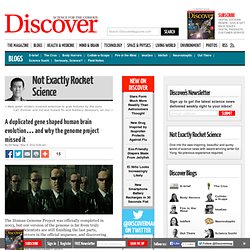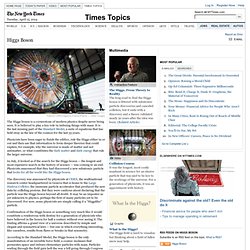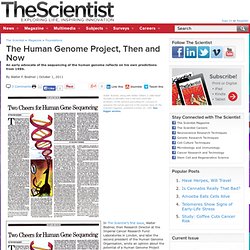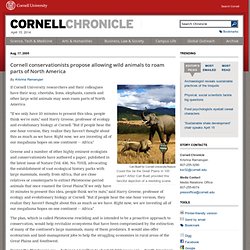

A duplicated gene shaped human brain evolution… and why the genome project missed it. The Human Genome Project was officially completed in 2003, but our version of the genome is far from truly complete.

Scientists are still finishing the last parts, correcting errors in the official sequence, and discovering new genes. These new genes did not go unnoticed because they are useless or insignificant. Some of them may be key players in our evolutionary story. Two groups led by Evan Eichler and Franck Polleux have found that humans, alone among all animals, have three extra copies of a gene called SRGAP2, which is involved in brain development. The second of these copies, SRGAP2C, is particularly interesting because it affects the development of neurons, and produces features that are distinctively human.
Genes are often duplicated by mistake when DNA is copied or shuffled around. Early sequencing attempts relied on ‘shotgun’ techniques that read small fragments of DNA and assembled them into a whole. The original gene is incredibly similar across different mammals. Higgs Boson. The Higgs boson is a cornerstone of modern physics despite never being seen.

It is believed to play a key role in imbuing things with mass. It is the last missing part of the Standard Model, a suite of equations that has held sway as the law of the cosmos for the last 35 years. Physicists have been eager to finish the edifice, rule the Higgs either in or out and then use that information to form deeper theories that could explain, for example, why the universe is made of matter and not antimatter, or what constitutes the dark matter and dark energy that rule the larger universe.
In July, it looked as if the search for the Higgs boson — the longest and most expensive search in the history of science — was coming to an end. Physicists announced that they had discovered a new subatomic particle that looks for all the world like the Higgs boson. Unfortunately, the model did not say how heavy the Higgs boson itself — the quantum personification of this field — should be. Excerpt from Santorum interview. Excerpt from Santorum interview The Associated Press An unedited section of the Associated Press interview, taped April 7, with Sen.

Rick Santorum, R-Pa. Words that couldn't be heard clearly on the tape are marked (unintelligible). AP: If you're saying that liberalism is taking power away from the families, how is conservatism giving more power to the families? SANTORUM: Putting more money in their pocketbook is one.
The Human Genome Project, Then and Now. An early advocate of the sequencing of the human genome reflects on his own predictions from 1986.

Walter Bodmer, along with Walter Gilbert, a 1980 Nobel laureate in chemistry and a Harvard University professor, wrote opinions advocating for a project to sequence the human genome in the premier issue of The Scientist magazine, published October 20, 1986. See bigger version. Neutrinos’ Speed in Question Because of Technical Problems, CERN Says. Dogging Mitt Romney. Seamus, the dog-on-the-roof, has become a kind of political icon.

You cannot go anywhere without running into him. There are Seamus T-shirts and endless Web sites. This week, the story was a New Yorker cover, with Rick Santorum playing the role of the Irish setter. Neil Swidey, the Boston Globe reporter who first broke the Seamus story in 2007, wrote recently that he had been avoiding a return to the topic for fear that someday the dog would wind up in the lead of his obituary. Which I can totally understand. The story took place in 1983, when the Romney family made a 12-hour pilgrimage from Boston to a vacation home in Canada. At some point — possibly in response to the excitement about being passed by tractor-trailers while floating like a furry maraschino cherry on top of the car, Seamus developed diarrhea. “It was a tiny preview of a trait he would grow famous for in business: emotion-free crisis management,” Swidey wrote.
People, does any of this sound appealing? CU researchers propose rewilding. Carl Buell for Cornell University/Nature Could this be the Great Plains in 100 years?

Artist Carl Buell provided this fanciful depiction of a rewilding scene. If Cornell University researchers and their colleagues have their way, cheetahs, lions, elephants, camels and other large wild animals may soon roam parts of North America. "If we only have 10 minutes to present this idea, people think we're nuts," said Harry Greene, professor of ecology and evolutionary biology at Cornell. "But if people hear the one-hour version, they realize they haven't thought about this as much as we have. Greene and a number of other highly eminent ecologists and conservationists have authored a paper, published in the latest issue of Nature (Vol. 436, No. 7053), advocating the establishment of vast ecological history parks with large mammals, mostly from Africa, that are close relatives or counterparts to extinct Pleistocene-period animals that once roamed the Great Plains.
" Keiji Iwai Photography.